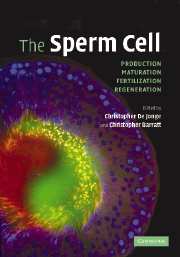Book contents
- Frontmatter
- Contents
- Preface
- List of contributors
- 1 Mammalian spermatogenesis and sperm structure: anatomical and compartmental analysis
- 2 Sperm chromatin stability and susceptibility to damage in relation to its structure
- 3 Genomic and proteomic approaches to defining sperm production and function
- 4 Sperm maturation in the human epididymis
- 5 Controls of sperm motility
- 6 Regulation of capacitation
- 7 Reactive oxygen species: friend or foe
- 8 Testing sperm manufacturing quality: the sperm–zona binding assay
- 9 Genetics: a basic science perspective
- 10 Sex chromosome abnormalities and male infertility: a clinical perspective
- 11 Epigenetic patterning in male germ cells: importance of DNA methylation to progeny outcome
- 12 The DAZ gene family and human germ cell development from embryonic stem cells
- Index
4 - Sperm maturation in the human epididymis
Published online by Cambridge University Press: 14 August 2009
- Frontmatter
- Contents
- Preface
- List of contributors
- 1 Mammalian spermatogenesis and sperm structure: anatomical and compartmental analysis
- 2 Sperm chromatin stability and susceptibility to damage in relation to its structure
- 3 Genomic and proteomic approaches to defining sperm production and function
- 4 Sperm maturation in the human epididymis
- 5 Controls of sperm motility
- 6 Regulation of capacitation
- 7 Reactive oxygen species: friend or foe
- 8 Testing sperm manufacturing quality: the sperm–zona binding assay
- 9 Genetics: a basic science perspective
- 10 Sex chromosome abnormalities and male infertility: a clinical perspective
- 11 Epigenetic patterning in male germ cells: importance of DNA methylation to progeny outcome
- 12 The DAZ gene family and human germ cell development from embryonic stem cells
- Index
Summary
Introduction
The current success of assisted reproduction using testicular sperm extraction may give the impression that the human epididymis is not necessary for the development of the fertilising capacity of spermatozoa. However, as all assisted reproduction techniques bypass the epididymal processes refined over millions of years of evolution to permit internal fertilisation naturally (Jones, 2002), this argument is disingenuous (see Cooper, 1990). Certainly, the scarcity of intact human epididymides and the unavailability of biopsies (Schirren, 1982) has delayed research on this organ in comparison with that on the human testis, but organs from autopsies and accident victims and at operations for prostatic carcinoma, radical prostatectomy and organ transplantation have provided information. The human epididymis does not present clear-cut divisions into head (caput), body (corpus) and tail (cauda) as in other species (Fig. 4.1) and the structural complexity of the human epididymal caput (Yeung et al., 1991) and the uncertainty of which regions have been sampled in many studies leave the field less clear than it could be. Unlike the mouse, where the expression is confined to the proximal caput epididymidis (Sonnenberg-Riethmacher et al., 1996), the proto-oncogene c-ros is expressed along the length of the human epididymis (Légaré and Sullivan, 2004). Nevertheless, the accumulated data obtained from these studies and reviewed here reveal a pattern of sperm maturation not unlike that found in other animals that have been studied more systematically.
- Type
- Chapter
- Information
- The Sperm CellProduction, Maturation, Fertilization, Regeneration, pp. 72 - 107Publisher: Cambridge University PressPrint publication year: 2006
- 18
- Cited by



